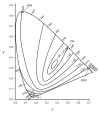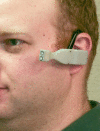Circadian light
- PMID: 20377841
- PMCID: PMC2851666
- DOI: 10.1186/1740-3391-8-2
Circadian light
Abstract
The present paper reflects a work in progress toward a definition of circadian light, one that should be informed by the thoughtful, century-old evolution of our present definition of light as a stimulus for the human visual system. This work in progress is based upon the functional relationship between optical radiation and its effects on nocturnal melatonin suppression, in large part because the basic data are available in the literature. Discussed here are the fundamental differences between responses by the visual and circadian systems to optical radiation. Brief reviews of photometry, colorimetry, and brightness perception are presented as a foundation for the discussion of circadian light. Finally, circadian light (CLA) and circadian stimulus (CS) calculation procedures based on a published mathematical model of human circadian phototransduction are presented with an example.
Figures





Similar articles
-
Of mice and women: light as a circadian stimulus in breast cancer research.Cancer Causes Control. 2006 May;17(4):375-83. doi: 10.1007/s10552-005-0574-1. Cancer Causes Control. 2006. PMID: 16596289 Review.
-
Nocturnal Melatonin Suppression by Adolescents and Adults for Different Levels, Spectra, and Durations of Light Exposure.J Biol Rhythms. 2019 Apr;34(2):178-194. doi: 10.1177/0748730419828056. Epub 2019 Feb 25. J Biol Rhythms. 2019. PMID: 30803301 Free PMC article.
-
A model of phototransduction by the human circadian system.Brain Res Brain Res Rev. 2005 Dec 15;50(2):213-28. doi: 10.1016/j.brainresrev.2005.07.002. Epub 2005 Oct 7. Brain Res Brain Res Rev. 2005. PMID: 16216333 Review.
-
Modeling Circadian Phototransduction: Quantitative Predictions of Psychophysical Data.Front Neurosci. 2021 Feb 5;15:615322. doi: 10.3389/fnins.2021.615322. eCollection 2021. Front Neurosci. 2021. PMID: 33613181 Free PMC article.
-
Circadian effectiveness of two polychromatic lights in suppressing human nocturnal melatonin.Neurosci Lett. 2006 Oct 9;406(3):293-7. doi: 10.1016/j.neulet.2006.07.069. Epub 2006 Aug 22. Neurosci Lett. 2006. PMID: 16930839
Cited by
-
Cycled light in the intensive care unit for preterm and low birth weight infants.Cochrane Database Syst Rev. 2024 Dec 19;12(12):CD006982. doi: 10.1002/14651858.CD006982.pub5. Cochrane Database Syst Rev. 2024. PMID: 39699174
-
The effects of sleep and light at night on melatonin in adolescents.Hormones (Athens). 2015 Jul-Sep;14(3):399-409. doi: 10.14310/horm.2002.1564. Hormones (Athens). 2015. PMID: 26233931 Free PMC article.
-
Evaluation of Daylight Perception Assessment Methods.Front Psychol. 2022 Apr 11;13:805796. doi: 10.3389/fpsyg.2022.805796. eCollection 2022. Front Psychol. 2022. PMID: 35478741 Free PMC article.
-
Pilot study of dynamic lighting and sleep consolidation among older adults in a Jordanian senior care facility.Sci Rep. 2025 Aug 29;15(1):31920. doi: 10.1038/s41598-025-17351-0. Sci Rep. 2025. PMID: 40883467 Free PMC article.
-
Access to Daylight at Home Improves Circadian Alignment, Sleep, and Mental Health in Healthy Adults: A Crossover Study.Int J Environ Res Public Health. 2021 Sep 23;18(19):9980. doi: 10.3390/ijerph18199980. Int J Environ Res Public Health. 2021. PMID: 34639284 Free PMC article.
References
-
- Moore-Ede MC, Sulzman FM, Fuller CA. The Clocks That Time Us. Cambridge: Harvard University Press; 1982.
-
- Lemmer B. Importance of circadian rhythms for regulation of the cardiovascular system: studies in animal and man. Conf Proc IEEE Eng Med Biol Soc. 2006;1:168–70. full_text. - PubMed
LinkOut - more resources
Full Text Sources
Other Literature Sources

